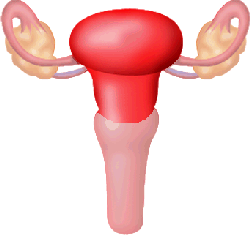The female genital tract consists of the ovaries (which contain the egg cells and cells which produce hormones such as oestrogen and progesterone); the fallopian tubes (which provide a pathway for the egg between the ovary and the uterus, and where fertilisation usually occurs); the uterus, or womb (designed for the development of the foetus); the vagina (via which, under normal circumstances, sperm is introduced during intercourse to fertilise the egg, and via which the baby is born), and the vulva, which constitutes what’s called the “external genitalia” - the only part visible to most of us - consisting of two thin folds of skin called the labia minora, and two thicker, outer, hair-bearing folds called the labia majora. The clitoris is a button of tissue which sits at the apex of the vulva, where the labia minora join together, which becomes erect due to increased blood flow during sexual arousal, and is analogous to the male penis. The bottom of the vulva is separated from the anus by a firm block of tissue called the perineal body. The whole of the area between this at the bottom and the clitoris at the top is called the perineum (because it’s this which is around the baby - or neonate - at birth). The uterus is a muscular organ shaped like a pear, about 8 cm long, divided into the fundus at the top, the body in the middle and the cervix, which protrudes into the vagina, at the bottom. The fallopian tubes enter at each side just below the fundus. The wall of the uterus is made up of smooth muscle, called the myometrium, and it has a glandular lining called the endometrium, designed to nourish a developing embryo. In the absence of fertilisation it is this lining which is shed during menstruation. The uterus usually leans forwards (called anteverted) but in 20% of women it leans backwards, towards the rectum (called retroverted). The cervix has a central canal: at the outer end, in the vagina, is the external, while the end in the uterus is the internal. This canal is about 2mm in diameter in the woman who has never been pregnant: it stretches to 10cm during labour and delivery. | |||
 | This information is licensed for use by Wellbeing Information Systems Ltd ("WIS"), and protected by international copyright law. All rights are reserved. (email info@wisinfo.co.uk). |
